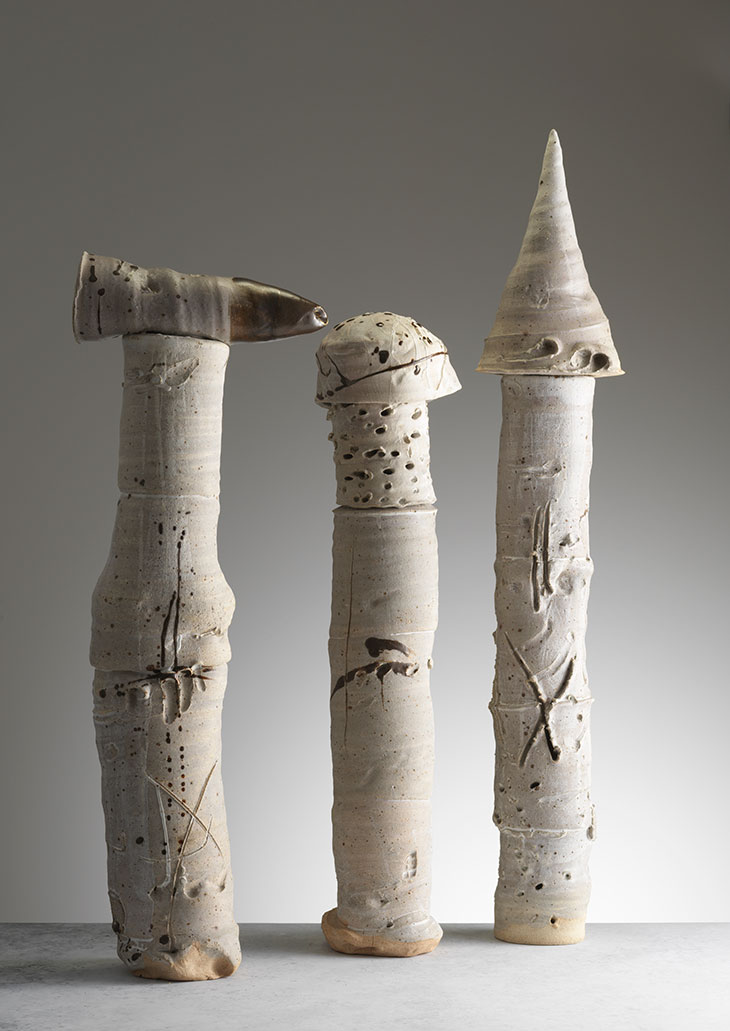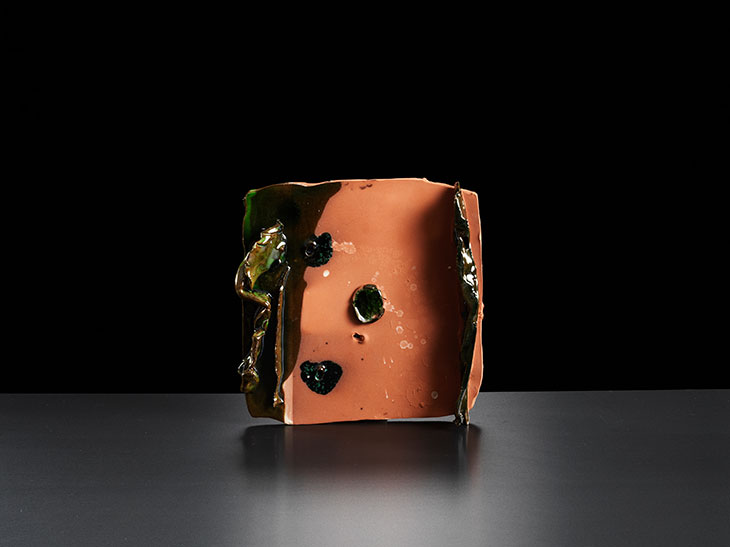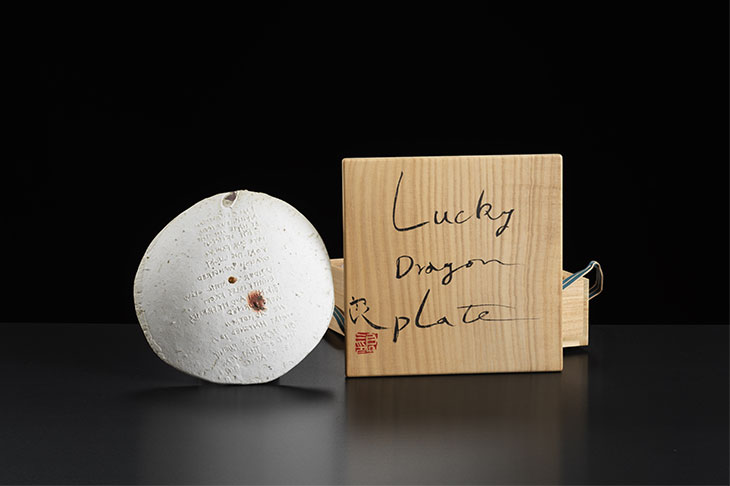Is there an age limit on being considered an enfant terrible? The Japanese ceramic artist Ryoji Koie, who died this summer at the age of 82, was long considered one of the most playful and provocative of his country’s potters. Born in 1938 in Tokoname – one of the Six Ancient Kilns of Japan, with more than 1,000 years of ceramic heritage – Koie found fame through the unconventional energy of his pottery and performances.
From the age of 10 Koie, who was born into a non-potting family, worked as a labourer in a drainage pipe factory, then as a tile maker at another. At 16, he began producing his own pots, before training at the Tokoname Municipal Ceramics Research Institute. From humble beginnings he developed his singular artistic approach, experimenting with materials such as soil, raw clay and found objects such as clocks and electronic circuitry. That same upending of expectation can be found throughout Koie’s work in fired clay.

The Clay Requiem (1991), Ryoji Koie. Photo: © Michael Harvey
One form he favoured was a thrown cylinder with its base removed, sliced vertically then laid open, turning the inside – the usually unseen inner walls – into the outside. These could become tea bowls, dishes or platters, each stretching the definition of what can be considered functional wares. Elsewhere he would slice, slash, slump or fuse pieces with an intuitive bravado that became his calling card. Instead of studying one type of pottery then spend a lifetime honing that skill, as is tradition, Koie moved between them freely, with a spontaneous virtuosity that spoke both to his skills as an artisan and his creative exuberance. The diversity of his output – in terms of materials, techniques and styles – is dramatic, spanning raku-firing, soda-firing and wood-firing; surface effects he explored range from glossy green oribe to the organic browns born of an anagama kiln’s flames.

Oribe style platter (c. 1990), Ryoji Koie. Photo: © Michael Harvey
Compare this experimentation to the historic world of Japanese pottery families, in which 30 generations may have made the same pots in the same ways, and the radicalism of such gestures is clear. ‘There are many handy people around, and just being a handy person is not good enough,’ said Koie in 2002. ‘I feel sorry for those skilful people. They do everything smoothly so therefore they don’t convey feelings in their work.’ Though he was unaffiliated with the movement, there’s a parallel here with the better-known Sodeisha group, who during the post-war period also set out to challenge the solemn rusticism of the Mingei folk craft movement.
Where others might spend a lifetime exploring the utensils of the tea ceremony, Koie took on another part of Japan’s national story: the atomic bombings of 1945. For Testimonies (1972–73), he fired household goods such as sewing machines and clocks with powdered clay, creating eerie sculptures that recall those tragic artefacts to be found in the museums of Hiroshima and Nagasaki. By the 1980s, Koie’s exploratory actions included ‘field burnings’: firing clay in the ground without a kiln, or scorching a line into the earth with a blowtorch as he walked from Tokoname to nearby Handa. In response to the disaster at Chernobyl’s nuclear power plant in 1986, he fired electronic circuit boards and lightbulbs on to porcelain tiles. Returning to Earth (1990) is one of 16 stoneware casts that show Koie’s face in various stages of disintegration; following his death, this series of masks has a particular pathos. This piece is now in the collection of the V&A; other works are held by the Metropolitan Museum of Art in New York and the National Museum of Modern Art in Tokyo, among others.

Lucky Dragon Plate (1992.), Ryoji Koie. Impressed lettering on the stoneware reads: ‘I am Fisherman Aikichi Kuboyama by name one of the first of many 1954 our fishing boat the lucky dragon wandered under atomic cloud 80 miles from Bikini and my friends were burned we did not now what happened to us on September 20 3rd of that year and died of atomic bomb’. Photo: © Michael Harvey
Koie relished travelling abroad to work with new clays, new kilns, new workshops: a process that demands an instinctive grasp of materials. As he put it, ‘To understand clay, you must have eyes not only in your fingernails but in your toenails too.’ The memorial exhibition ‘Ryoji Koie: A Tribute’ at Oxford Ceramics Gallery (25 September–31 October) marks a return of his work to one of those many cities in which he once worked. The ceramicist Margaret O’Rourke, at whose studio in Oxford he created his inimitable pieces, remembers him as ‘a man full of life and madness’.

In praise of Ryoji Koie, the enfant terrible of Japanese ceramics
Ryoji Koie (1938–2020) photographed outside his studio in Japan in 2017. Photo: © Michael Harvey
Share
Is there an age limit on being considered an enfant terrible? The Japanese ceramic artist Ryoji Koie, who died this summer at the age of 82, was long considered one of the most playful and provocative of his country’s potters. Born in 1938 in Tokoname – one of the Six Ancient Kilns of Japan, with more than 1,000 years of ceramic heritage – Koie found fame through the unconventional energy of his pottery and performances.
From the age of 10 Koie, who was born into a non-potting family, worked as a labourer in a drainage pipe factory, then as a tile maker at another. At 16, he began producing his own pots, before training at the Tokoname Municipal Ceramics Research Institute. From humble beginnings he developed his singular artistic approach, experimenting with materials such as soil, raw clay and found objects such as clocks and electronic circuitry. That same upending of expectation can be found throughout Koie’s work in fired clay.
The Clay Requiem (1991), Ryoji Koie. Photo: © Michael Harvey
One form he favoured was a thrown cylinder with its base removed, sliced vertically then laid open, turning the inside – the usually unseen inner walls – into the outside. These could become tea bowls, dishes or platters, each stretching the definition of what can be considered functional wares. Elsewhere he would slice, slash, slump or fuse pieces with an intuitive bravado that became his calling card. Instead of studying one type of pottery then spend a lifetime honing that skill, as is tradition, Koie moved between them freely, with a spontaneous virtuosity that spoke both to his skills as an artisan and his creative exuberance. The diversity of his output – in terms of materials, techniques and styles – is dramatic, spanning raku-firing, soda-firing and wood-firing; surface effects he explored range from glossy green oribe to the organic browns born of an anagama kiln’s flames.
Oribe style platter (c. 1990), Ryoji Koie. Photo: © Michael Harvey
Compare this experimentation to the historic world of Japanese pottery families, in which 30 generations may have made the same pots in the same ways, and the radicalism of such gestures is clear. ‘There are many handy people around, and just being a handy person is not good enough,’ said Koie in 2002. ‘I feel sorry for those skilful people. They do everything smoothly so therefore they don’t convey feelings in their work.’ Though he was unaffiliated with the movement, there’s a parallel here with the better-known Sodeisha group, who during the post-war period also set out to challenge the solemn rusticism of the Mingei folk craft movement.
Where others might spend a lifetime exploring the utensils of the tea ceremony, Koie took on another part of Japan’s national story: the atomic bombings of 1945. For Testimonies (1972–73), he fired household goods such as sewing machines and clocks with powdered clay, creating eerie sculptures that recall those tragic artefacts to be found in the museums of Hiroshima and Nagasaki. By the 1980s, Koie’s exploratory actions included ‘field burnings’: firing clay in the ground without a kiln, or scorching a line into the earth with a blowtorch as he walked from Tokoname to nearby Handa. In response to the disaster at Chernobyl’s nuclear power plant in 1986, he fired electronic circuit boards and lightbulbs on to porcelain tiles. Returning to Earth (1990) is one of 16 stoneware casts that show Koie’s face in various stages of disintegration; following his death, this series of masks has a particular pathos. This piece is now in the collection of the V&A; other works are held by the Metropolitan Museum of Art in New York and the National Museum of Modern Art in Tokyo, among others.
Lucky Dragon Plate (1992.), Ryoji Koie. Impressed lettering on the stoneware reads: ‘I am Fisherman Aikichi Kuboyama by name one of the first of many 1954 our fishing boat the lucky dragon wandered under atomic cloud 80 miles from Bikini and my friends were burned we did not now what happened to us on September 20 3rd of that year and died of atomic bomb’. Photo: © Michael Harvey
Koie relished travelling abroad to work with new clays, new kilns, new workshops: a process that demands an instinctive grasp of materials. As he put it, ‘To understand clay, you must have eyes not only in your fingernails but in your toenails too.’ The memorial exhibition ‘Ryoji Koie: A Tribute’ at Oxford Ceramics Gallery (25 September–31 October) marks a return of his work to one of those many cities in which he once worked. The ceramicist Margaret O’Rourke, at whose studio in Oxford he created his inimitable pieces, remembers him as ‘a man full of life and madness’.
Unlimited access from just $16 every 3 months
Subscribe to get unlimited and exclusive access to the top art stories, interviews and exhibition reviews.
Share
Recommended for you
Wheel of fortune – the life and achievements of Bernard Leach
A century after the founding of the Leach Pottery in St Ives, the ‘father of British studio pottery’ remains an influential, if contested, figure
The great modern potter who made an art form of buttons
A comprehensive look at the career of Lucie Rie places the spotlight on her handcrafted buttons
Warren MacKenzie’s commitment to craft
The renowned American potter believed simplicity, beauty, and affordability were of paramount importance